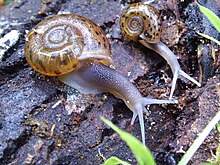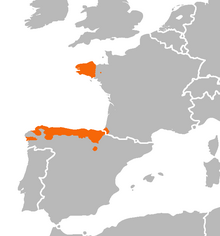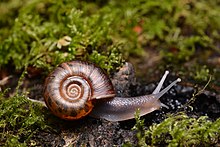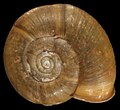Escargot de Quimper
You can help expand this article with text translated from the corresponding article in French. (July 2009) Click [show] for important translation instructions.
|
| Escargot de Quimper | |
|---|---|

| |
| Scientific classification | |
| Kingdom: | Animalia |
| Phylum: | |
| Class: | |
| (unranked): | clade Heterobranchia
clade Euthyneura clade Panpulmonata clade Eupulmonata clade Stylommatophora informal group Sigmurethra |
| Superfamily: | |
| Family: | |
| Genus: | Elona |
| Species: | E. quimperiana
|
| Binomial name | |
| Elona quimperiana | |

| |
| Synonyms | |
|
Helix quimperiana Férussac, 1821 | |
Elona quimperiana,
Elona is a
This snail is mentioned in annexes II and IV of the Habitats Directive.
Original description
Elona quimperiana was originally described (under the name Helix quimperiana) by André Étienne d'Audebert de Férussac in 1821.[3]
Férussac's original text (the
QUIMPERINA, nobis. pl. fig.
α) Nobis. pl. LXXVI (par erreur LXVI), fig. 2.
Habit. Les bords de Briec l'Odet, près Quimper en Bretagne. Elle a été découverte par Mrs De Kermovan et Bonnemaison; Comm. Desmarest.
Which means in English:
"Habitat: Margin of
De Kermovan and Bonnemaison."Shell description
The shell is umbilicate and planorboid in shape. The spire is slightly concave. The periphery is broadly rounded, corneous with a few varicoid white stripes.[5] The shell has five or six whorls.[6]
The aperture is lunar and slightly oblique. The lip is white, expanded above, reflexed below, with the ends distant.[5]
The width of the shell is 20–30 mm. The height of the shell is 10–12 mm.[6]
-
apical view
-
apertural view
-
umbilical view
Anatomy


The jaw has 11-16 narrow ribs.[5]
The anatomy of Elona quimperiana was described in detail by Alfred Moquin-Tandon already in 1855-1856[7] and later by Gittenberger (1979).[8]
Reproductive system: the genitalia have club-shaped mucous glands, in other words, the mucous glands are shortened into somewhat rounded triangular sacks. Mucous glands shaped like this are unusual in the Helicoidea, but are typical of the Elonidae. The dart sack is inserted in a sort of calyx at base. The love dart is curved at the end, with lens-like section.[5] (Drawing of reproductive system by Gittenberger 1979.)
Distribution
This species is found in France and Spain.
The Lusitanian snail Elona quimperiana has a remarkably disjunct distribution, limited to northwestern France (Brittany), northwestern Spain and the Basque Country.[4]
Habitat
This species lives in temperate and humid deciduous forests.[4]
Life cycle
Like other pulmonates, snails and slugs, the Quimper snail is hermaphrodite. Sexual maturity is reached at about two years of age. Mating takes place at mid-season and laying, usually underground, is deposited in tiny natural tunnels of the soil. There are two annual breeding periods in Brittany, with hatching occurring in the spring (April–May) and in the fall (September–October).[9]
Feeding habits
This species of snail feeds on mycelia found on rotten, dead stumps (principally oak). Occasionally, it is
See also
A closely related species is
References
This article incorporates
- . Retrieved 17 November 2021.
- ^ Adams H. & Adams A. (1858). The genera of recent Mollusca; arranged according to their organization. In three volumes. Vol. II., pp. [1-3], 1-661. London. (Van Voorst).
- ^ a b c (in French) Férussac A. E. J. P. J. F. d'Audebard de ([1821-1822]). Tableaux systématiques des animaux mollusques classés en familles naturelles, dans lesquels on a établi la concordance de tous les systèmes; suivis d'un prodrome général pour tous les mollusques terrestres ou fluviatiles, vivants ou fossiles. pp. j–xlvij [= 1–47], [1], 1–110, [1]. Paris, Londres. (Bertrand, Sowerby). Description on page 39.
- ^ .
- ^ Manual of Conchology, structural and systematic, with illustrations of the species. Second series: Pulmonata. Volume 9. Helicidae – Volume VII. Continued by H. A. Pilsbry, page 307-308.
- ^ a b (in German) Kerney M.P., Cameron R.A.D. & Jungbluth J.H. (1983). Die Landschnecken Nord- und Mitteleuropas. Hamburg/Berlin, 384 pp., page 242-243.
- ^ (in French) Moquin-Tandon A. (1855-1856). Histoire naturelle des mollusques terrestres et fluviatiles de France, contenant des études générales sur leur anatomie et leur physiologie et la description particulière des genres, des espèces et des variétés. Volume 2 (4-5), 368 pp., J.-B. Baillière, Paris. Elona quimperiana at pages 129-131. plate XI, figure 9-14, description of plate XI.
- ^ Gittenberger E. (1979). On Elona (Pulmonata, Eloniadae fam. nov.) Malacologia Volume 18, 1-2, Sixth European Malacological Congress, Amsterdam, 139-145.
- ^ Daguzan, J. & Gloaguen, JC (1986). "Contribution to the ecology of Elona quimperiana (de Férussac) (Gastropod Pulmonate Stylommatophore) in western Brittany". Haliotis. 15: 17–30.
{{cite journal}}: CS1 maint: multiple names: authors list (link)
Further reading
- (in French) Daguzan J. & Gloaquen J. C. (1986). "Contribution à l'écologie d'Elona quimperiana (de Férussac) (Gastéropode Pulmoné Stylommathophore) en Bretagne occidentale". Haliotis 15: 17–30.




